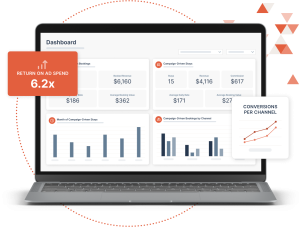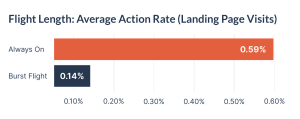Always-on marketing takes a dynamic and ongoing approach to digital.
Every destination marketer battles seasonal swings. One week, your destination is bursting with guests, the next your crowds are gone.
While it’s tempting to scale back marketing efforts during low seasons or even during economic uncertainty, travelers are booking and planning anytime and anywhere.
Always-on marketing can help you capitalize on that demand.
Destinations traditionally plan media in “flights” or episodic campaigns designed to support specific business goals or marketing strategies.
A burst flight is a campaign running for less than 21 days. An always-on marketing strategy uses real-time traveler intent data, audience segmentation,
and personalized messaging over a longer period of time to reach and engage travelers. With always-on, you can support the high seasons and capture demand during the shoulder seasons.
Our data found that 92% of always-on campaigns exceeded expectations compared to 58% with burst flights.
What’s more, US destination campaigns that took an always-on approach had a 33% lower cost per action (CPA) than burst media flights.
An always-on campaign takes a more dynamic and ongoing approach to digital marketing.
These campaigns focus on collecting data to discover travelers who will make the most impact on your destination, love what you have to offer, and keep coming back.
By building the right datasets, you can capitalize on always-on campaigns to entice travelers to discover, plan, and book their next holiday to your destination.

Collect First-Party Data to Find High-Value Travelers
Collecting data has traditionally been a major challenge for Destination Marketing Organizations (DMOs).
A first-party data strategy allows you to collect data about your potential travelers and use that information to share relevant messaging to drive travelers to your destination.
First-party data includes data from your website, CRM data, and other data, such as travel intent data and in-person interactions.
You can collect first-party data in a variety of ways:
- Build out your subscription email list for drip campaigns and newsletters
- Create dynamic pages for your different audiences
- Track and collect data from media familiarization trips, sales missions, and trade shows
- Collect customer feedback about their experiences
- Update and enrich your CRM databases
- Deploy lead generation campaigns
- Track website visits and behaviors
While it may sound difficult to get started with first-party data, you’re probably closer than you think to building a sustainable, permission-based audience strategy, if you’ve done any of the above. When you combine first-party data with an always-on strategy, you can use fresh data to continually identify your most valuable customers and deliver relevant messaging that will inspire them to take action.
Strategically targeting your potential travelers will improve the overall traveler experience and encourage them to take action.
Our data found that always-on campaigns had an incredible 328% higher action rate compared to burst flights.

Bolster Traveler Profiles With Third-Party Insights
Beyond first-party data, you can still supplement always-on campaigns with third-party data, such as demographic and lifestyle information. While you shouldn’t rely on third-party data moving forward, third-party sources can help you build up your own datasets and strengthen your traveler profiles to get to know your audiences better.

